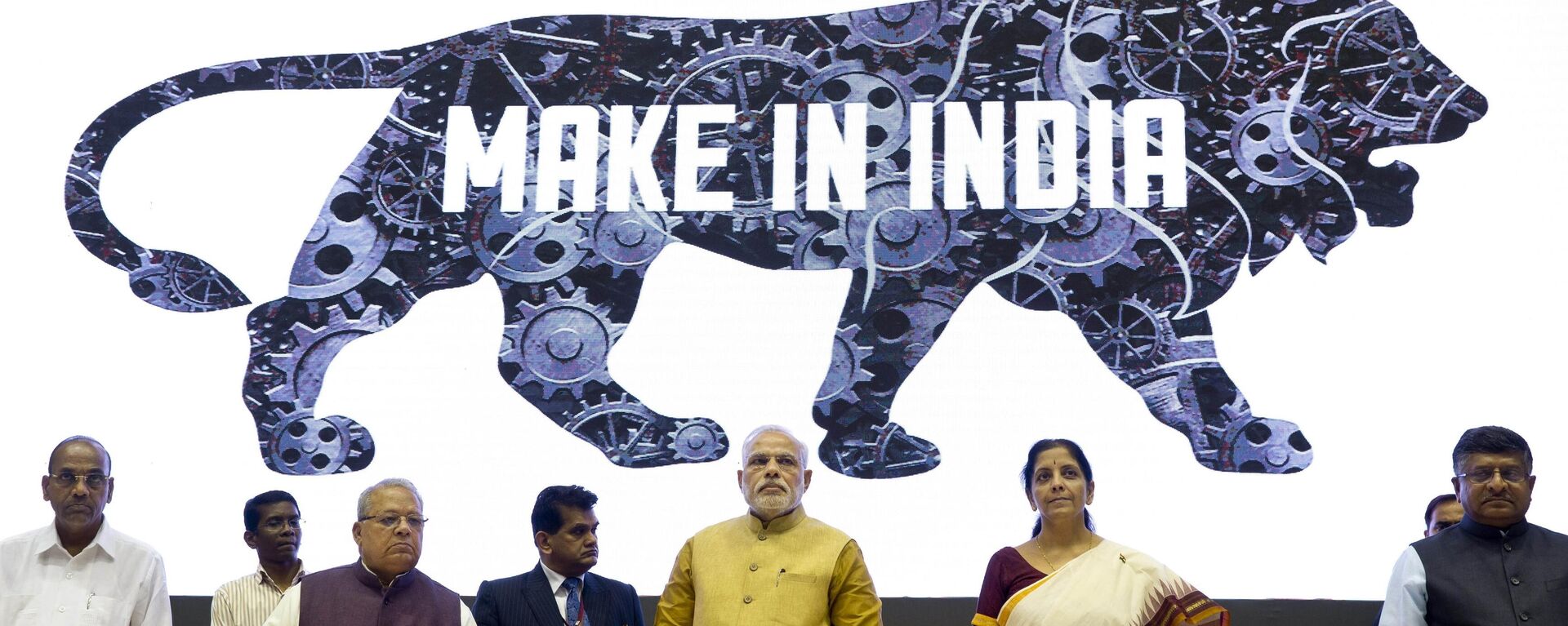https://sputniknews.in/20240624/why-do-the-indian-air-force-and-navy-want-to-buy-home-grown-10-tapas-drones-7696705.html
Why Do the Indian Air Force and Navy Want to Buy Home-Grown 10 TAPAS Drones?
Why Do the Indian Air Force and Navy Want to Buy Home-Grown 10 TAPAS Drones?
Sputnik India
Tactical Airborne Platform for Aerial Surveillance (TAPAS) drones seeks to compete with imported counterparts from Israel and the American Predator MQ-9B... 24.06.2024, Sputnik India
2024-06-24T22:06+0530
2024-06-24T22:06+0530
2024-06-24T22:57+0530
defenсe news
india
israel
red sea
indian air force (iaf)
indian navy
government of india
ministry of external affairs (mea)
ministry of defence (mod)
maritime security
https://cdn1.img.sputniknews.in/img/07e8/01/10/6218277_0:4:1278:723_1920x0_80_0_0_fa6d5839357ad5c7a56cf6121c05b744.png
The Indian Air Force tend to buy 10 Indian-made surveillance drones to bolster indigenous unmanned surveillance capabilities, officials said on Sunday. Of those airfcrafts, six would be allocated to the Indian Air Force and the remaining four to the Indian Navy, defence officials told ANI.The IAF will spearhead the process of acquiring and integrating the TAPAS drones into the armed forces.It is anticipated that the proposal from the military department to be discussed by the Defence Ministry soon. Officials said that at present, only those two forces are involved in procuring the aircrafts.According to him, the IAF is supportive of its ongoing development under the 'Make in India' initiative, hence, the operational advancement of this platform have been tentatively approved.Golani emphasised that it was reflected in the initial order for "10 aircraft aimed at validating operational testing."The Armed Forces, as per him, are committed to promoting indigenous development and self-reliance, embodying the principles of Atmanirbharata. However, some of these initiatives require financial support and assistance to conduct operational testing, he noted, and due to delays in the project timeline, "this backing was crucial to facilitate progress".TAPAS: Enhancing Surveillance Capabilities with Long-Range Unmanned Aerial AssetsIn the meantime, the necessity for long-range unmanned aircraft is clear, according to retired Captain Sarabjeet S. Parmar, Distinguished Fellow at United Service Institution of India.He believes that TAPAS aims to rival imported drones from abroad, particularly in terms of endurance and payload capacity for civilian applications, referring to Israeli aircraft and the US Predator MQ-9B.Additionally, as payloads increase, endurance naturally decreases, influencing the drone's operational efficiency and its ability to sustain surveillance tasks in specific areas over extended periods, Parmar noted.The former officer assured that as long as "drones like TAPAS or Drishti 10 can meet these standards, the demand for drones will persist", particularly in terms of ease of deployment and operational range.He underlined that endurance and sustained operational capability are crucial factors, ensuring that surveillance needs are consistently met without interruption.Strengthening India's Self-RelianceThe analyst pointed out that, if the drones demonstrate success, their numbers are expected to grow, presenting numerous potential advantages.In the meantime, building the TAPAS in India mitigates concerns about potential future sanctions, the military pundit highlighted.The expert asserted also that strategically positioning these drones in key areas maximizes their operational benefits, providing valuable insights for ongoing enhancements and meeting specific operational requirements. He then added that the framework encapsulates how the potential of TAPAS and other indigenous unmanned aerial vehicle, including Drishti 10, are viewed.Furthermore, having drones that both the Air Force and Navy can utilize enhances logistical efficiency, the analyst underscored.
https://sputniknews.in/20240119/india-needs-to-ditch-western-defence-components-for-the-sake-of-make-in-india-6269063.html
india
israel
red sea
south asia
south china sea
indian ocean
Sputnik India
feedback.hindi@sputniknews.com
+74956456601
MIA „Rossiya Segodnya“
2024
Swapna Nair
https://cdn1.img.sputniknews.in/img/07e7/09/12/4320104_0:0:681:681_100x100_80_0_0_ca8a7d4d582609272840ffdd1cde7278.jpg
Swapna Nair
https://cdn1.img.sputniknews.in/img/07e7/09/12/4320104_0:0:681:681_100x100_80_0_0_ca8a7d4d582609272840ffdd1cde7278.jpg
News
en_IN
Sputnik India
feedback.hindi@sputniknews.com
+74956456601
MIA „Rossiya Segodnya“
Sputnik India
feedback.hindi@sputniknews.com
+74956456601
MIA „Rossiya Segodnya“
Swapna Nair
https://cdn1.img.sputniknews.in/img/07e7/09/12/4320104_0:0:681:681_100x100_80_0_0_ca8a7d4d582609272840ffdd1cde7278.jpg
indian air force, tapas drones, indigenous unmanned surveillance capabilities, indian air force, indian navy, tapas drones, defence ministry, air force, ‘make in india’ initiative, air vice marshal anil golani (retd, director general at centre for air power studies (caps) , indian armed forces, indigenous development and self-reliance, atmanirbharata, surveillance capabilities, long-range unmanned aerial assets, anti-piracy operations, red sea, surveillance capabilities, captain sarabjeet parmar (retd), distinguished fellow at united service institution of india, maritime domain, especially in the vast indian ocean region, india's self-reliance, fostering competition in drone, india's self-reliance (aatmanirbhar bharat) initiative, domestic manufacturing capabilities, drishti 10, air force and naval stations
indian air force, tapas drones, indigenous unmanned surveillance capabilities, indian air force, indian navy, tapas drones, defence ministry, air force, ‘make in india’ initiative, air vice marshal anil golani (retd, director general at centre for air power studies (caps) , indian armed forces, indigenous development and self-reliance, atmanirbharata, surveillance capabilities, long-range unmanned aerial assets, anti-piracy operations, red sea, surveillance capabilities, captain sarabjeet parmar (retd), distinguished fellow at united service institution of india, maritime domain, especially in the vast indian ocean region, india's self-reliance, fostering competition in drone, india's self-reliance (aatmanirbhar bharat) initiative, domestic manufacturing capabilities, drishti 10, air force and naval stations
Why Do the Indian Air Force and Navy Want to Buy Home-Grown 10 TAPAS Drones?
22:06 24.06.2024 (Updated: 22:57 24.06.2024) Tactical Airborne Platform for Aerial Surveillance (TAPAS) drones seeks to compete with imported counterparts from Israel and the American Predator MQ-9B, focusing specifically on endurance and payload capacity for civilian applications, according to experts.
The Indian Air Force tend to buy 10 Indian-made surveillance drones to bolster indigenous unmanned surveillance capabilities, officials said on Sunday. Of those airfcrafts, six would be allocated to the Indian Air Force and the remaining four to the Indian Navy, defence officials told ANI.
The IAF will spearhead the process of acquiring and integrating the TAPAS drones into the armed forces.
It is anticipated that the proposal from the military department to be discussed by the Defence Ministry soon. Officials said that at present, only those two forces are involved in procuring the aircrafts.
"Currently, the TAPAS drone are in process to meet the stringent requirements set by the Air Force and other branches of the Indian Armed Forces," retired air vice marshal Anil Golani, Director-General at the Centre for Air Power Studies (CAPS) told Sputnik India.
According to him, the IAF is supportive of its ongoing development under the 'Make in India' initiative, hence, the operational advancement of this platform have been tentatively approved.
Golani emphasised that it was reflected in the initial order for "10 aircraft aimed at validating operational testing."
The Armed Forces, as per him, are committed to promoting indigenous development and self-reliance, embodying
the principles of Atmanirbharata. However, some of these initiatives require financial support and assistance to conduct operational testing, he noted, and due to delays in the project timeline, "this backing was crucial to facilitate progress".
TAPAS: Enhancing Surveillance Capabilities with Long-Range Unmanned Aerial Assets
In the meantime, the necessity for long-range unmanned aircraft is clear, according to retired Captain Sarabjeet S. Parmar, Distinguished Fellow at United Service Institution of India.
"The demand for Unmanned Aerial assets is evident, considering the recent successful deployments of drones in anti-piracy operations, notably in the Red Sea, highlight their potential," the expert told Sputnik India.
He believes that TAPAS aims to
rival imported drones from abroad, particularly in terms of endurance and payload capacity for civilian applications, referring to Israeli aircraft and the US Predator MQ-9B.
Additionally, as payloads increase, endurance naturally decreases, influencing the drone's operational efficiency and its ability to sustain surveillance tasks in specific areas over extended periods, Parmar noted.
The former officer assured that as long as "drones like TAPAS or Drishti 10 can meet these standards, the demand for drones will persist", particularly in terms of ease of deployment and operational range.
The maritime domain, especially in the vast Indian Ocean region, requires "a growing number of assets for effective surveillance, emphasizing quality over sheer quantity," Parmar insisted.
He underlined that endurance and sustained operational capability are crucial factors, ensuring that surveillance needs are consistently met without interruption.
Strengthening India's Self-Reliance
The analyst pointed out that, if the drones demonstrate success, their numbers are expected to grow, presenting numerous potential advantages.
"Firstly, it bolsters India's self-reliance (Aatmanirbhar Bharat) initiative, fostering domestic manufacturing capabilities," Parmar said. "Secondly, it stimulates healthy competition within the country to develop superior equipment, focusing on quality over quantity and reducing procurement costs."
In the meantime, building the TAPAS in India mitigates concerns about potential future sanctions, the military pundit highlighted.
The expert asserted also that strategically positioning these drones in key areas maximizes their operational benefits, providing valuable insights for ongoing enhancements and meeting specific operational requirements. He then added that the framework encapsulates how the potential of
TAPAS and other indigenous unmanned aerial vehicle, including Drishti 10, are viewed.
Furthermore, having drones that both the
Air Force and Navy can utilize enhances logistical efficiency, the analyst underscored.
"This interoperability between services enhances command coordination and operational effectiveness," Parmar concluded.



